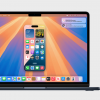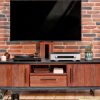The picture and audio quality of the Sharp VL-Z7U is comparable to other DV cameras that I’ve seen and used. Great audio and video aside, if your camera is a bear to hold and operate, then it’s not going to be much fun to use. This is an area where Sharp shines. It’s a fun camera to use.
It’s All in the Grip.
The first thing you will notice when you take the Sharp out of the box is that the body is split so that the grip/tape drive portion rotates individually from the lens/viewfinder portion. My first thought was, “so what?” Well here’s what. When you grip the camera the conventional way without any rotation, there is pressure on the wrist and it’s hard for the thumb to reach the record button unless you’re double jointed. But, rotate the grip portion and you will be amazed at how the wrist straightens out and the thumb falls on the record button with no pressure. Since everyone’s hand size is different, it’s just a matter of finding the proper rotation. Although I usually don’t shoot one handed, this camera is easy to hold with one hand due to its low weight (slightly over one pound) and rotating grip.
No Groping For the Main Camera Controls
Switching from tape mode to digital still camera mode is a snap. There is a clearly marked media selection switch right on the back of the hand grip section at the top. To snap a still picture press the photo button on the top of the grip. It’s easy to reach with your index finger without groping. Use the same photo button to capture a still on tape The still image on tape is one of the best I’ve seen. Once the image is captured on tape, use the record button to control the number of seconds you want the image to appear on the tape.
The zoom control is also at the top just in front of the photo button. It’s easy to reach and operate. The maximum optical zoom is 10X which is sufficient for most situations. Avoid using the 500X digital zoom unless you like looking at a screen full of pixels. The zoom motor is very quiet. I placed my ear right next to the camera while zooming in and out and could not detect any noise.
Beneath the media selection switch is a standby button which will save your battery when you need to pause for short periods. Don’t just give it a quick push. It took a full two seconds of holding the button in to activate the standby. One good push will release it though and your picture will be immediately visible in the viewfinder. This is preferable to turning the camera off because it takes about three seconds to get the picture back after you turn the camera on.
The main camera control on the back of the hand grip is an outer ring that allows you to easily switch from the off position to camera mode or playback mode. The record button is located in the center of the ring. Once you rotate the grip to a comfortable position these may operated easily with your thumb.
Menu Controls Are Tricky
Unfortunately the menus are not as easy to use. On the VL-Z7U, you activate the menu by hitting the “display” button on the left side. At first I found this a little confusing because I kept looking for the “menu” button which isn’t there. Of course the directions are in the manual, but I only use that as a last resort.
You must push the display button twice to get to the menu, The first push will display recording information like remaining battery life, time code (if on), audio (12 or 16 bit), focus settings (auto or manual) and an icon indicating that the Digital Image Stabilization (DIS) is turned on. The factory setting of DIS is off, so you may want to turn this on and leave it. The second push brings up the menus. To turn the menus off push display again which turns everything off. Then if you like the display information visible during shooting you have to push display again. That’s a little too much button pressing for my taste.
Once you do get to the menu, the list is very confusing. You will first see a list of items that Sharp calls the “mode screen”. You access these items by using the up, down, right, and left arrows on the joystick which is located on the upper left side of the camera. The mode items include: BLC/Gain (Backlight compensation or gain up in low light), Fade, Scene Menu (including slow shutter, night lumi, party, sunlight, dusk, sport, and off which is the default), Manual Set, Focus, Auto Focus, Date Disp, and LCD set. That’s a lot to navigate through right there, but there’s another one called “Menu.” Once you activate the menu you get additional menus labeled “Setting 1”, “Setting 2” , and then “Others 1”, and “Others 2”, each with it’s own list of option choices. I’m not complaining about the number of available options, just the way they’re listed. Of course once you get most of the settings the way you want, you will most likely not change them.
You must press the arrow controls on the joystick just right to get it to do what you want. This takes a little practice, It is especially difficult to operate the joystick while you are shooting, and there may be times that you need to do just that. For example, you can turn the “fade” to on while you’re not recording with no problem. The problem is that after you fade in, the button remains on until you stop recording. When you hit the record button to stop recording, you get a fade out which you may not want. So, while you’re shooting you have to figure out how to turn the fade button off (and keep the camera steady at the same time.) Conversely if you start with the Fade in the off position and want to fade out, you have to turn the Fade to “on” while shooting. It’s a little tricky to do this.
To operate the menu controls while shooting, I settled on cradling the left side (lens/viewfinder section) of the camera in my left hand and operating the display button/joystick with my left thumb. This helps to steady the camera and your hand is not in the way of the view screen as you shoot.
Lots of Features
On the plus side, I like the top loading tape mechanism. This feature is so important to me that I will not buy a camera with a bottom loading tape mechanism. Why? Because I tape a lot of live events using a tripod and sometimes I need to make a quick tape change. The extra time it takes to take the camera off the tripod to change the tape could cause me to miss some important action.
The 2.5-inch CG Silicon LCD screen is the best I’ve seen in bright sunlight. It’s so good that there is probably little reason to ever use the eyepiece viewfinder which also views in color (another nice feature). Using the viewfinder will save some battery life.
I like the audio dubbing feature in addition to the video dubbing feature that’s standard on most Mini DV video cameras. If you’re into non-linear editing on the computer, audio dubbing may not be that important to you, but if you’re not it’s an excellent feature for adding voice over or music to your videos.
Another plus is the ability of the VL-Z7U to convert analog tapes to digital. You can convert all your old VHS analog tapes to DV and then capture it on the computer through firewire rather than using a separate capture card on the computer to digitize your old tapes. This feature has to be turned on (default setting) to work. It’s accessed through the menus in the playback mode.
Sharp supplies a set of A/V cables for receiving analog video or for outputting to the TV for watching. One end has the standard yellow, red, and white RCA jacks as well as an S-video connection, but the other end is proprietary to Sharp and plugs into a jack labeled AV on a hidden panel behind a plastic cover on the rear of the camera. Don’t lose this set because it’s not something you can pick up cheap from any video store. Other jacks on this panel include USB (cable included), DV (firewire cable not included), Headphones, and a port for the power supply. If you want to shoot using the external power supply, you can access the port by opening a separate “DC-in” cover at the bottom rather than the entire plastic cover which would expose all the jacks.
On the minus side, there is no room for a larger (longer life) battery. The thin battery supplied by Sharp tucks into the body of the camera behind the LCD screen. Maximum battery life with the LCD open and recording is 100 minutes according to Sharp, so you will probably need to purchase some extras if you have a lot of battery powered shooting to do. The battery charges in the camera, and has a two hour charging time. A power (green) charge (red) light is located just below the standby button on the rear of the grip. Sharp does not sell a separate battery charger as an optional accessory.
Another minus is the fade in/out, which goes to white rather than black. This is a little disconcerting to my eye when I watch videos. I’d much prefer black.
Digital still images are saved on the 8MB SD memory card that comes in the box. The quality of the 1280×960 maximum resolution is nothing to rave about. It’s sufficient for slide shows but not for great prints. While it’s a nice convenience, it’s not a feature that I’d pay a premium for. I’d rather save the extra cost of the digital still feature and apply it to the cost of a high resolution digital still camera.
Great Remote For Playback
Move the outer ring that surrounds the record button to the right (playback mode); connect the A/V cables to your TV, or VCR for making VHS copies for family/friends and you’re in business.
It’s easier to operate the playback controls through the supplied remote control card, than the hard-to-use arrow buttons on the joystick for PLAY (up), STOP (down), REW (left) and FF (right). The remote is great. It’s about the size of a credit card, but slightly thicker. It will let you operate the still images off the memory card also, as well as displaying date, time, and time code. Other functions on the remote include: volume, a record button used to put yourself in the picture away from the camera, pause, and slow motion playback.
Unfortunately, you cannot use the remote to operate the menus in playback mode. You’re back to the same cumbersome menu system, but this time you have a whole new set of choices to wade through. Some of the many available menu options in playback mode include: analog to digital (on/off previously mentioned), Pic Effect (B/W, sepia, solarization, negative, off), and one called “Rotate PB” which will rotate the picture 180 degrees upside down when activated. The “Pic Effects” and rotation feature are not important to me.
Summary
This review does not cover every feature that the VL-Z7U offers. Rather it’s an overview of the ones that I think are important enough to mention in order to make a buying decision.
On the plus side, it’s light, compact, fun to use and easy to handle with the rotating grip. The video/audio quality is comparable to other Mini DV cameras. The LCD screen is the best I’ve seen. I also like the audio dubbing, top loading tape, and analog to DV features.
On the minus side, the menu layout is cumbersome. The controls to operate it are difficult to use. I have enough experience to overcome this, but it may be tough for the novice shooter. The lack of a longer life battery may also be a turnoff for some purchasers.
So to answer the question: “Is the Sharp VL-Z7U worth owning?” My answer is yes, depending on price. The MSRP of $899 is too high compared to other comparable cameras on the market. A check of “Hot Deals” on eCoustics turned up prices ranging from $449.00 to $649.99. There were eight merchants offering the VL-Z7U for under $500.00. At those prices this camera is well worth it, either as a first time purchase for beginners or a backup camera for serious videographers.
Pros
• Compact and easy to handle
• Rotating grip
• Top loading tape
• Analog to digital conversion
• Bright LCD screen
• Remote control features
• Firewire and USB jacks
• Headphone jack
• Audio dubbing
Cons
• Menu layout is confusing
• Hard-to-use joystick
• No long life battery option
• Fades to white
• No neck strap
• No index in manual
Lee Mitchell has been a “semi professional” video maker for 22 years. He has made and sold videos of weddings, bar mitzvahs, baptisms, funerals, concerts, plays, sports, and birthday parties, but he enjoys making his family videos the most.
























